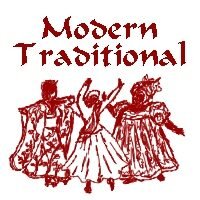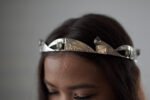 They are put on the forehead to symbolize the importance and worship of intellect, and are said to stimulate the third eye, when placed between the eyes.
They are put on the forehead to symbolize the importance and worship of intellect, and are said to stimulate the third eye, when placed between the eyes.
Tilaka are generally worn by religious men and married women. The look and color of them will depend on their beliefs as individuals, or which sect they are from, and what occasion it is. Vaishnavists generally wear vertical lines, where Shaivites generally wear horizontal lines, but, depending on local customs, all may wear a sort of “smear” of sandalwood, vermillion, or another colorful powder, when they have visited someone who wishes to give them a sort of a spiritual gift. It is not uncommon to see foreheads lovingly smeared in the airports of the world.
Generally, if a woman is wearing a red, circular tilaka or bindi, or a bindi that is red, or has a red dot somewhere in it, it means that she is married. Both married and unmarried women often wear bindis of other colors, but if it is red, the woman is making a point that she is married. This is the traditional situation in most places anyway. Though sometimes a red bindi may be for other occasions or reasons, it is best for someone who is not Indian to not break this usual standard.
Tikka are mostly worn in very formal occasions or weddings, though there are some that are made to be a little more casual. One who sweats alot, for instance, may choose a casual tikka over a bindi or tilaka. The more casual sort can be easily made at home, and make nice gifts.
 Some contemporary folk like to wear their bindi someplace other than the forehead, such as at the corner of one’s sunglasses. They also make a nice alternative to give high school students, rather than the typical gold star for good behavior.
Some contemporary folk like to wear their bindi someplace other than the forehead, such as at the corner of one’s sunglasses. They also make a nice alternative to give high school students, rather than the typical gold star for good behavior.
When purchasing bindi, in order to avoid cultural insult or confusion, it is important to know what various symbols mean. Most that are sold to westerners were bought by people who don’t really know much about Asian symbolism. So here is a list of common bindi shapes, and their meanings
| Symbol used as bindi: | Meaning: |
| teardrop or circle | a drop or blessing from the deities. |
| circular with designs within | the divine discus, presented by Vishnu to Shiva, as a gift. |
| paisley | a stylized Muslim symbol for the pine cone, OR contemporary symbol of moral freedom, tolerance, and peace. |
| swan | tribal symbol for beauty, family, and communal values OR Vishnu. |
| flame | fire, intensity, Shiva in the form of fire. |
| snake | Nag (the deity), fertility, cunning/intelligence, a “dark” sensibility. |
| spider | creativity, weaving, creation |
| elephant trunk | Ganesha, wisdom, strength. |
| mirrors or reflective | in some tribes it means protection from evil eye, reminder that what you do comes back, karma. |
| “hollow” teardrop or eye shape | the Yoni, Shakti, womanhood. Careful, as if it is shaped like a noose, it is the symbol of the deity of death catching his victims. It may mean the wearer is “Gothic”. |
| square | four elements, diamonds. |
| sunburst | the sun |
| trident | a weapon of Shiva, symbolizing creation, destruction, and regeneration. |
| spear | victory, the vanquishing of enemies, or removal of obstacles. |
| eye | invokes Shiva, Kali, or shows reverence to the Nepalese “Khumari” or living goddess. The Khumari is chosen in toddlerhood, based on her fearlessness and closeness to perfection, and much revered until her term ends, at the first time she ever bleeds for any reason. However, it is said that those who marry a former Khumari are sure to have a tragic death. |
Where to Buy Bindi
Though bindi are sold in many places, like with any other item that is so closely connected to a culture or spirituality of a specific people, it is best to prioritize Indian or regional/south Asian stores. Local availability and various options may prevent this, but it’s good to try. Another priority option should be people who are Hindu, Buddhist, Jain, adherent to regional deities, and have some spiritual connection to south Asia and her people. I am currently restocking my list of favorite stores, so add your links or email me directly if you own or know of a good one.
Other Uses for Bindi
Some of you out there like me went a little crazy when bindi were in fashion worldwide and stocked up. For me, it’s because I’m an African spiritualist, and all that jazz about the third eye and pineal gland, some science based and some not. It was just a nice little reminder and hey, I am a little sterotypically into face ornamentation. I ended up though, with tons more bindi than I would ever use in my life. Then I remembered that unless they are stuck on the forehead, they are just stickers. If one is spiritually aware in their everyday life, it doesn’t hurt to spread the beauty around a bit. I did ask Hindu adherents before suggesting these things. If any of these would be offensive to you, feel free to inform me of the details and any regional or specific religious sect issues.
I have 35 so far…
- The obvious, to harness or focus the energy of the third eye, indicate that you’re married, or show your philosophical affiliation.
- As a parting gift to guests.
- Instead of a piercing, or to cover piercings that have not yet closed. A dab of scar gel may help it stick and aid in healing.
- As a beauty mark, on the cheek or cleavage.
- Instead of those difficult to use nail decals and rhinestones.
- As temporary decoration for your jeans.
- To add a little glitz to those plain black pumps or boots.
- As the high school “good job” alternative to gold stars.
- Enhancements for your tattoos.
- To make an interesting collage.
- To ornament your book covers, scrap book, journal, etc…
- To spruce up the look of your computer’s monitor.
- Plain ones can be convenient grippers for pens and pencils, especially makeup pens.
- Nipple friction protection for male runners and cold weather atheletes.
- To cover your smallpox immunization scar. (Hello, my fellow Navy vets 🙂 )
- To seal your letters and notes.
- To decorate your eyeglasses.
- Put in a small notepad for quick color therapy.
- To mark favorite pages or passages in a book.
- Plain ones can be used to keep the corners of wooden or laquered boxes from getting chipped or wearing down, or just about anything else adhesive felt is good for, but will look nicer.
- To decorate a plain headband, hair clip, or barette.
- To remind you not to scratch a mosquito bite.
- To decorate your bandages or cast.
- If you are an Indigenous crafter, and you find one that is appropriate, use it as the drawing bead in a dreamcatcher or adze trap.
- To decorate your hand mirror or compacts.
- To dress up your computer’s mouse.
- To sort your keys.
- To mark the festival dates on your calendar.
- To add a special touch to a greeting card.
- Pretty grippers for your mouse, to prevent those worn down looking areas.
- Traction for pens and pencils.
- A cute way to mark whose water bottle is whose in the fridge or cooler.
- If you’re trying to get your birds to mate, humanely and carefully applying one to the male will get him much more attention.
- < Excellent gifts to give your customers.
- Decorations for utensil handles, chopsticks, and twizzle sticks
Thank you for reading my page on bindi. I hope that it is helpful and enhances your beauty and spiritual practice. Blessings and Ashe!









